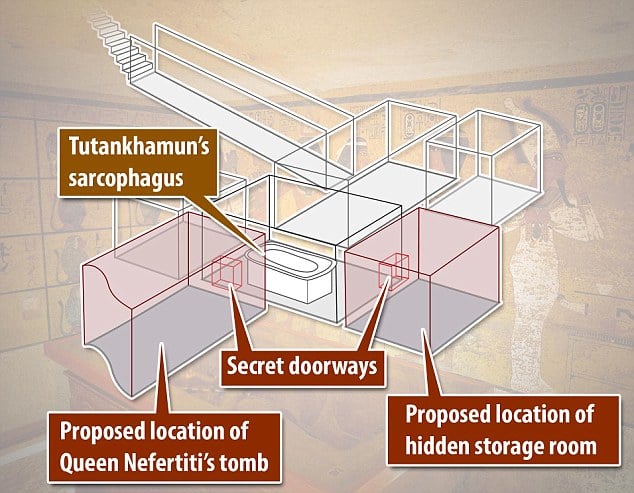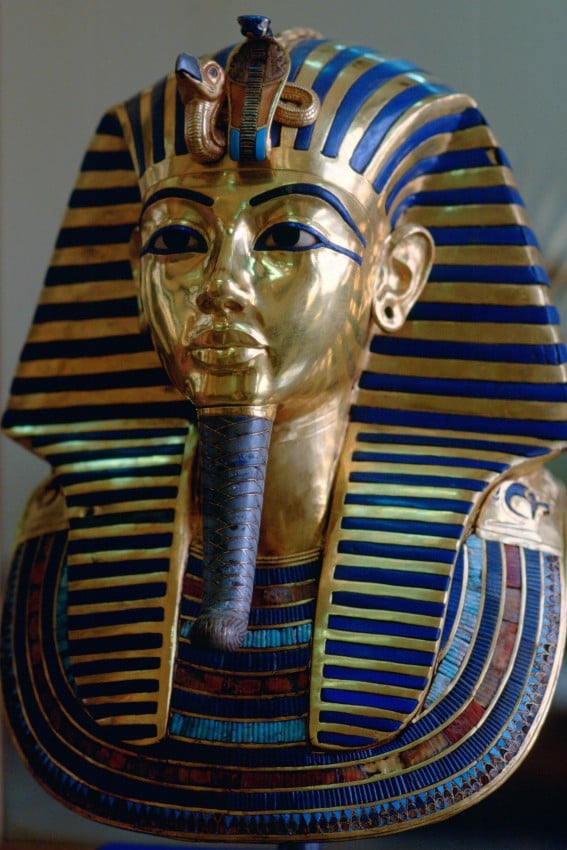Art World
Secret Door to Nefertiti’s Lost Burial Chamber Found in King Tut’s Tomb
This could be one of the biggest archaeological discoveries ever made.

This could be one of the biggest archaeological discoveries ever made.

Sarah Cascone

Does the tomb of Tutankhamun hold a secret passageway to the burial chamber of Queen Nefertiti? One researcher believes he has found evidence of a sealed-off door that he believes led to the famously-beautiful Egyptian ruler’s tomb.
Nicholas Reeves of the University of Arizona has published a paper, “The Burial of Nefertiti?” based on his belief that high-resolution scans of the tomb (taken to create a life-size copy of the space) show traces of two walled-over doorways beneath the painted walls. He speculates that the “ghost” doorways would have led to a storage chamber and to “the undisturbed burial of the tomb’s original owner—Nefertiti.”
Egyptologists are divided as to the parentage of King Tut, but one theory holds that Nefertiti, chief wife of Tut’s father, the Pharaoh Akhenaten, gave birth to the boy-king. (A recent autopsy indicates that Tutankhamun was crippled, possibly because he was the product of incest.)

The funerary mask of King Tutankhamun at the Cairo Museum, Egypt. Photo: Tim Graham, courtesy Getty Images.
Since the famed 1922 discovery of King Tut’s tomb by Howard Carter, archaeologists have wondered at the burial chamber’s relatively small size. Reeves’s theory offers a neat explanation to this lingering question: King Tut’s tomb was a mere antechamber added onto Nefertiti’s larger burial chamber.
The hidden tomb, if it exists, would be to the right of the entrance shaft, as was traditional for Egyptian queens. The former doorway is now decorated with religious scenes, which Reeves speculates would have been part of a ritual protection for Nefertiti’s final resting place.
Reeves also contends that King Tut’s richly adorned tomb is actually full of secondhand objects (possibly even his famed, recently-damaged funerary mask), some of which seem to indicate that Nefertiti served as the boy’s co-regent. Nefertiti’s known titles do suggest she helped rule the country following Akhenaten’s death, possibly as co-regent or even as pharaoh in her own right.

Nefertiti bust in Neues Museum, Berlin.
Photo: Philip Pikart, via Wikimedia Commons.
“If digital appearance translates into physical reality, it seems we are now faced not merely with the prospect of a new, Tutankhamun-era store room to the west [but] that of Nefertiti herself, celebrated consort, co-regent, and eventual successor of Pharaoh Akhenaten,” wrote Reeves.
“I would be very surprised if this tomb was built to house the original, or first, burial of Nefertiti,” countered Joyce Tyldesley, a senior lecturer in Egyptology at the University of Manchester, to the Times. “It seems to me that it is highly likely that she died during her husband’s reign…but I would have expected her to be buried somewhere in the Western Valley, rather than in the center of the Valley of the Kings.”
Luckily, it is fairly easy to begin to check Reeves’s theory using non-invasive means. Radar scans should reveal whether or not there are any hollow chambers adjacent to King Tut’s tomb. If so, a team of experts would likely be brought in to conduct a careful excavation.
“Each piece of evidence on its own is not conclusive, but put it all together and it’s hard to avoid my conclusion,” Reeves insisted to the Economist. “If I’m wrong I’m wrong, but if I’m right this is potentially the biggest archaeological discovery ever made.”
Related Stories:
Confusingly Huge and Ugly Public Sculpture of Queen Nefertiti Taken Down in Egypt
Alexander the Great-Era Tomb Yields Amazing New Murals of 4th Century BC Life
Rare Alexander the Great Mosaic Unearthed in Ancient Synagogue in Israel
Alexander the Great Tomb Yields Newly-Discovered Mosaic
Archaeologists Unearth 2,000-Year-Old Treasures in Grave of Ethiopian Sleeping Beauty